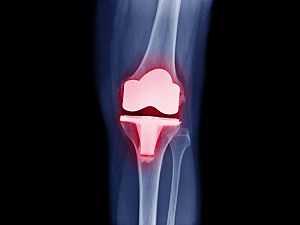It’s well established that patients’ presurgical expectations can influence their outcomes after surgery, including total knee arthroplasty (TKA). However, most research in this area has relied on single follow-up time-points rather than characterizing the postsurgical recovery period in detail.
Robert R. Edwards, PhD, a psychologist in the Center for Pain Medicine at Brigham and Women’s Hospital, Junie S. Carriere, PhD, of the Université de Sherbrooke, and colleagues explored the impact of expectancies on outcomes at three time points after TKA. In Pain Medicine, they report that presurgical expectancies about pain reduction and functional improvement significantly predicted those outcomes only at the one-year follow-up.
Methods
The 200 patients included in the retrospective study completed a set of questionnaires before unilateral TKA and at two or three of the postoperative times of interest: six weeks, six months, and/or one year. The measures were:
- Presurgery only: separate visual analog scales (0–100) about knee pain and functional limitation expected six months postoperatively
- Western Ontario and McMaster Universities Osteoarthritis Index (WOMAC)
- Visual analog scale (0–100) for knee pain expected at six months postoperatively
- Visual analog scale (0–100) for functional limitation expected at six months postoperatively
- Pain Catastrophizing Scale
- Patient-Reported Outcomes Measurement Information System (PROMIS) Anxiety item bank
- PROMIS Depression item bank
At each follow-up time, patients were also asked to rate their pain reduction and improvement in function on separate scales of 0 to 100.
Shorter-term Follow-up
Before surgery, the mean pain expectancy score was 13.8, and the mean functional limitation expectancy score was 14.4.
Pain and functional limitation expectancies did not predict outcomes at the six-week and six-month follow-ups. However, two psychological factors predicted shorter-term functional improvement:
- Pain catastrophizing was a significant predictor of functional improvement at six weeks (β, −0.59; P=0.043)
- Depressive symptoms were a significant predictor at six months (β, −1.18; P=0.032)
One-year Follow-up
Presurgical expectancies about pain significantly predicted pain reduction at the one-year follow-up, and presurgical expectancies about function significantly predicted functional improvement. This was true even after adjustment for age, sex, body mass index, WOMAC score, pain catastrophizing, and symptoms of depression and anxiety.
Applying the Findings to Practice
Symptoms such as pain and swelling can last several months after TKA, so some individuals may not have started to recover until six months after surgery. It’s possible that in the short term, psychological distress (pain catastrophizing and depressive symptoms) associated with health-related factors outweighed the effects of expectancies.
Those short-term findings have implications for the nature of postoperative interventions. Catastrophizing and depression have been associated with analgesic misuse, decreased activity, and other factors that might affect outcomes.
In the long term, psychological distress associated with health-related factors may become less relevant than non–health-related factors such as expectancies. This suggests postsurgical TKA care may benefit from a more phase-specific, multifactorial approach.
The findings of this study also suggest expectancies should be considered part of the standard screening of patients being considered for TKA. The two visual analog scales are a simple way to identify patients at risk of poorer outcomes and could guide the personalization of pain-management strategies.
